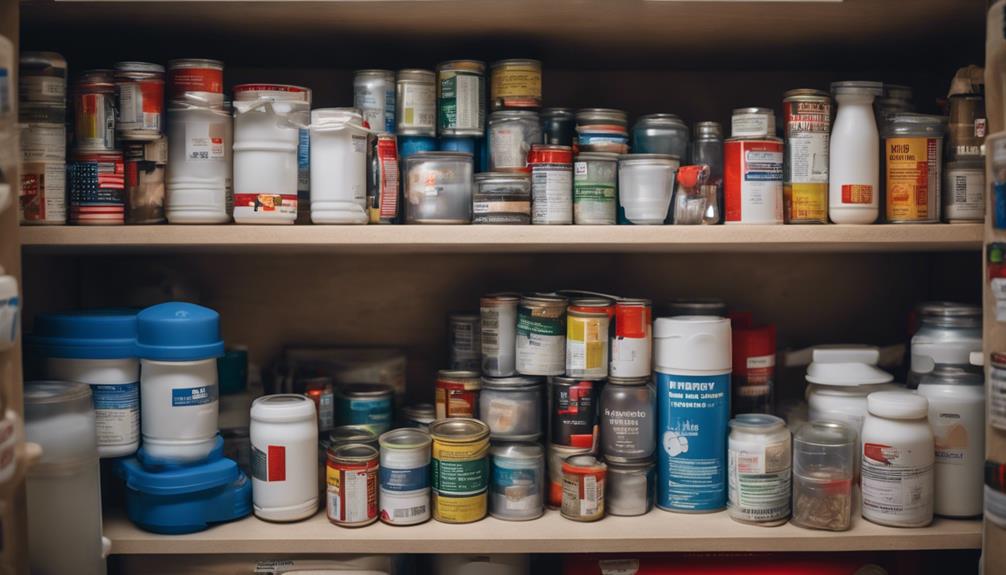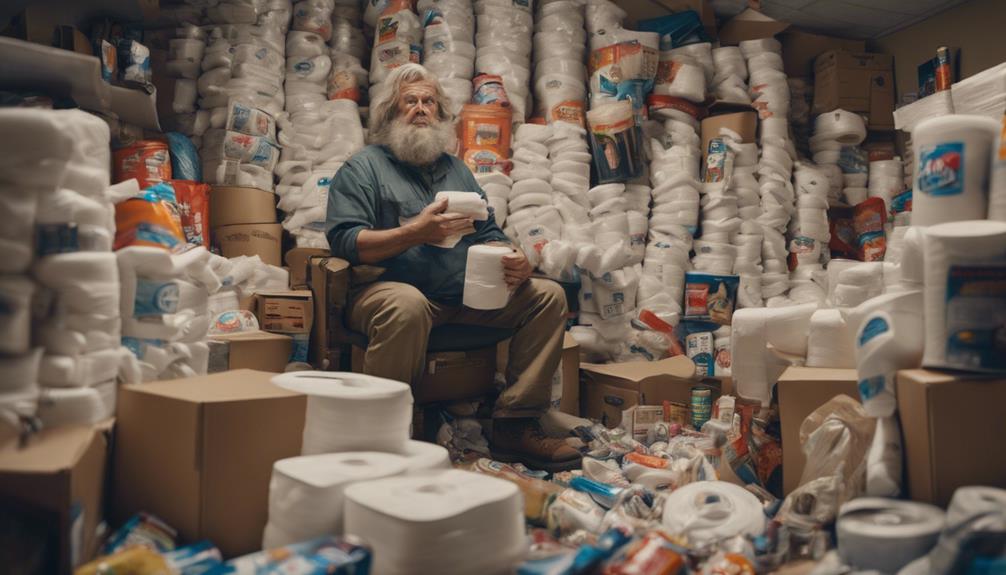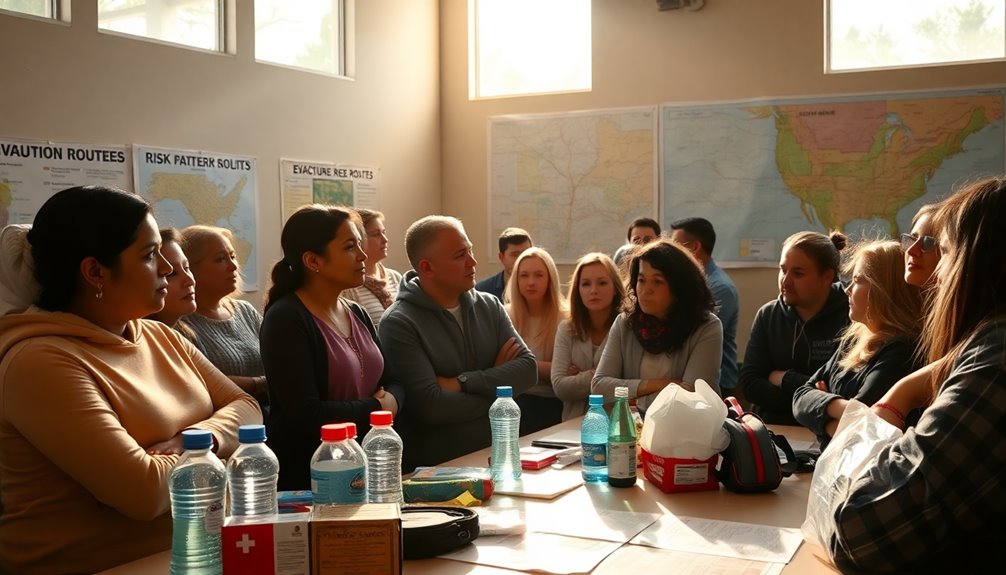To be fully prepared, make sure you have shelter supplies like tents, tarps, sleeping bags, and extra clothing for comfort and warmth. Stock up on water containers, purification tablets, and stackable barrels for clean drinking water. Fill your pantry with dry staples, canned goods, and freeze-dried food for sustenance. Equip a detailed first aid kit with bandages, medications, and training materials. Essential items like water containers, first aid kits, and batteries are crucial for survival. Be prepared with protection items like firearms and bear spray. Stock tradeable goods for bartering in times of need. These basics set you up for any emergency.
Key Takeaways
- Shelter, Water, Food, First Aid, Protection items are essential prepper supplies.
- Stock water containers, purification tools, and food for emergencies.
- Include first aid kits, medications, and personal hygiene items.
- Firearms, ammunition, and biometric safes are crucial for protection.
- Tradeable goods like food, water, and tools are valuable for bartering.
Shelter Prepping Supplies
Make sure you have all the essential shelter prepping supplies, such as tents, tarps, sleeping bags, and extra clothing, to stay protected and comfortable during emergencies. In times of crisis, these items play an important role in ensuring your safety and well-being.
Tarps, for instance, are incredibly versatile. They can be used to create temporary shelter, protect belongings from rain, or even as a ground cover to keep moisture at bay.
When it comes to sleeping bags, having ones designed for survival situations is key. These bags offer insulation to retain body heat, keeping you warm when temperatures drop. Additionally, extra clothing in your shelter prepping supplies is essential for staying dry and warm amidst challenging conditions.
Water Prepping Supplies

Guarantee your readiness by stocking up on water prepping supplies. When preparing for emergencies, water is essential for survival. Consider investing in stackable water containers to store the recommended 1 gallon per person per day. These containers are practical and space-efficient.
Additionally, having water barrels provides a larger storage capacity for extended emergencies. To make certain your water is safe to drink, water purification tablets and portable filters like LifeStraws are vital. These tools help eliminate harmful contaminants from questionable water sources.
Collapsible water containers are handy for their portability, while rainwater collection systems in barrels or buckets offer a renewable water source during crises. Don't forget electrolyte hydration powder to maintain proper hydration levels in stressful situations.
Food Prepper Supplies

When preparing your food prepper supplies, remember to stock up on dry bulk staples like rice, beans, and pasta for long-term storage.
Consider including freeze-dried food options for lightweight and easy-to-prepare meals during emergencies.
Don't forget to add canned goods such as fruits, vegetables, and proteins to make sure you have convenient and durable food options available.
Food Storage Essentials
Stock up on essential food prepper supplies to guarantee you're prepared for any situation. When it comes to food storage, long shelf life is key. Dry bulk staples like rice, beans, and pasta are excellent choices for extended storage periods. They provide essential nutrients and are versatile for various meal options.
Another popular option is freeze-dried food, known for its long shelf life and lightweight properties, making it ideal for emergency situations. Canned goods are a must-have in your prepper pantry, offering convenience, variety, and a longer shelf life. Vegetables, fruits, and meats in cans provide essential nutrients and can be easily incorporated into meals.
In addition to these staples, vacuum-sealed items help preserve perishable foods like meats and cheeses, extending their shelf life significantly. Remember, proper rotation of your food supplies is vital to maintain freshness and avoid waste in your prepper stockpile.
Emergency Rations Guide
Make sure your emergency rations supply includes a variety of non-perishable items like canned goods, freeze-dried food, and energy bars. When stocking up on emergency food items, consider the shelf life to guarantee they remain viable during times of need.
Remember, having at least a two-week supply of food per person is essential for survival in emergencies. To help you with your emergency rations, here are some essential tips:
- Rotate your food prepper supplies regularly to maintain freshness and prevent waste.
- Take into account any dietary restrictions and preferences when selecting emergency rations for your prepper supplies.
- Include a variety of food items in your emergency rations to ensure nutritional balance and meal options.
- Check the expiration dates on all food items to make sure they're safe to consume when the need arises.
Meal Planning Tips
Make sure you have a sufficient quantity of non-perishable food items stored for emergency meal planning, aiming for at least a two-week supply. When selecting food for your emergency supplies, opt for nutrient-dense options like canned proteins, grains, and dried fruits to guarantee balanced meals. It's essential to rotate and check the expiration dates on your food prepper supplies every six months to maintain freshness and quality. Additionally, include a manual can opener in your supplies to access canned goods during emergencies easily. To cater to special dietary needs or preferences, such as gluten-free or vegetarian diets, stock up on specific items accordingly.
| Non-Perishable Items | Meal Planning Tips |
|---|---|
| Canned Protein | Choose nutrient-dense foods for balanced meals. |
| Grains | Rotate and check expiration dates every six months. |
| Dried Fruits | Include a manual can opener in your supplies. |
| Specific Diets | Plan for special dietary needs or preferences. |
| Gluten-Free Options | Stock up on specific items accordingly. |
First Aid Prepping Supplies

Enhance your first aid preparedness by equipping yourself with essential supplies like bandages, ointment, and antihistamines in a ready-made kit. Ensuring you have a well-stocked first aid kit is an important step in being prepared for emergencies. Here are some items to contemplate including in your first aid prepping supplies:
- First aid kit: A detailed kit containing bandages, gauze pads, adhesive tape, scissors, and gloves.
- Necessary medications: Include pain relievers, antiseptic wipes, antihistamines for allergic reactions, and any prescription medications you may need.
- Personal hygiene: Don't forget items like wet wipes for cleaning hands and surfaces, nail clippers to prevent infections, razors for personal grooming, and feminine hygiene products if applicable.
- Training materials: Basic first aid guides and instructional materials to refresh your memory on emergency procedures.
Essential Prepper Items

Including essential prepper items in your emergency preparedness kit is important for ensuring you're ready for a variety of survival situations. Water containers are essential for storing clean water, especially when faced with contaminated water sources.
First aid kits are indispensable for treating injuries and illnesses that may arise during emergencies. Rechargeable batteries power essential devices like flashlights, radios, and communication tools, ensuring you stay connected and informed.
Having these items readily available can make a significant difference in how well you can navigate through unexpected challenges. Water containers provide a means to stay hydrated and maintain good hygiene. First aid kits offer the necessary supplies to address medical needs promptly. Rechargeable batteries keep your tools functioning when traditional power sources are unavailable.
Protection Items

To guarantee your safety and security during emergencies, it's important to consider essential protection items for your prepper supply. When preparing for potential threats, consider the following items:
- Guns: Firearms are essential for self-defense in extended emergency situations.
- Ammo: Adequate ammunition is necessary to make sure your firearms can be used effectively.
- Biometric Gun Safes: Secure storage of your guns is imperative, and biometric gun safes provide quick and reliable access while keeping them out of unauthorized hands.
- Bear Spray: In addition to human threats, protection against wildlife is crucial. Bear spray offers a non-lethal means of defense in such situations.
Tradeable Goods

Tradeable goods are crucial for preppers as they can be exchanged for necessities during a crisis.
Items like guns, ammo, and survival supplies hold value and can be used in bartering situations when traditional currency isn't an option.
Having a variety of tradeable goods guarantees you're prepared to trade for essential items like food, water, and medical supplies when needed.
Bartering in Crisis
During a crisis, engaging in bartering can be an essential strategy for obtaining essential items when traditional commerce is disrupted. Bartering in emergency situations involves trading goods or services for necessary supplies.
Here are some key points to take into account when it comes to bartering and tradeable goods:
- Tradeable Goods: Common items for bartering include food, water, medical supplies, ammunition, and fuel.
- Community Connections: Bartering can help establish relationships within your community by exchanging goods and services.
- Valuable Skills: Skills like medical knowledge, repair abilities, or language proficiency can be valuable assets for bartering.
- Diversification: Having a variety of tradeable goods increases your chances of obtaining the supplies you need during a crisis.
Essential Exchange Items
In emergency situations, having essential exchange items ready for bartering can greatly increase your chances of obtaining necessary supplies. When considering tradeable goods for survival scenarios, think about items like ammo, non-perishable food, medications, hygiene products, and tools. These goods are highly sought after and can be used to barter for other essentials.
Here is a breakdown of essential exchange items for bartering:
| Tradeable Goods | Description | Importance |
|---|---|---|
| Ammo | Scarce and high in demand, useful for self-defense and hunting | Critical |
| Non-perishable Food | Canned goods and snacks provide sustenance and energy | Essential |
| Medications | Essential for health and well-being, crucial in emergencies | Vital |
| Hygiene Products | Wet wipes, soap, and toothpaste maintain cleanliness and prevent illness | High Demand |
| Tools | Knives, multi-tools, and fire-starting equipment aid in survival tasks and utility purposes | Versatile |
Having these tradeable goods on hand can help you navigate through tough times by exchanging them for the supplies you need in a crisis.
Survival Kit Supplies

Make sure your survival kit is well-stocked with essential supplies for emergency situations. Here are some vital items to include in your list of survival kit supplies:
- Water and Food: Pack non-perishable food items like granola bars and canned goods, along with enough water to last at least three days.
- Light and First Aid: Include a flashlight with extra batteries, a first aid kit with necessary medications, and a multipurpose tool like a Swiss Army knife.
- Emergency Shelter: Have a tent or tarp, a sleeping bag or warm blankets, an emergency whistle, a dust mask, and plastic sheeting with duct tape for shelter repairs.
- Communication Tools: Carry a battery-powered or hand-crank radio for updates, a cell phone charger with a backup power source, local maps for evacuation routes, a whistle, and a solar charger for electronic devices.
Ensure your survival kit is tailored to meet your specific needs and environment, providing you with the necessary tools to stay safe and secure during unforeseen circumstances.
Medicine Essentials

Stockpile essential medications and first aid supplies to make sure your preppers supply is equipped for medical emergencies. In addition to over-the-counter medications like pain relievers and antihistamines, it’s wise to have prescription medications on hand if possible. Make sure your preppers first aid kit essentials include items like bandages, antiseptic wipes, and splints for treating wounds or injuries. Having a well-rounded supply of both medications and basic medical tools can significantly improve your chances of handling emergencies without immediate professional help.
Make certain you have a sufficient supply of necessary medications, both prescription and over-the-counter, to address health needs during an emergency. Additionally, include first aid supplies such as bandages, antiseptics, and pain relievers in your emergency kit for immediate care.
Consider specific medical items like epinephrine injectors for allergies or insulin for diabetics if needed. Stay up to date on basic first aid procedures and CPR techniques to be well-prepared for handling medical emergencies effectively.
Regularly check and rotate your medications and first aid supplies to maintain their potency and avoid using expired items. By having a well-stocked medicine kit and first aid supplies, you can make sure you're ready to handle any unexpected medical situations that may arise.
Community Preparedness

Engage with your community to enhance disaster resilience and create a network of support in times of emergencies. By fostering a culture of community preparedness, you can strengthen your neighborhood's ability to respond effectively to disasters.
Consider the following key actions to bolster your community's readiness:
- Establish Communication Channels: Open lines of communication within your community to share crucial information and coordinate response efforts swiftly.
- Organize Community Drills: Practice emergency scenarios with your neighbors to make sure everyone knows their roles and responsibilities in times of crisis.
- Support Community Emergency Response Teams (CERTs): Get involved with CERTs to receive training in essential disaster response skills and contribute to aiding others during emergencies.
- Build Relationships and Create Emergency Contact Lists: Strengthen bonds with your neighbors, participate in neighborhood watch programs, and compile contact lists to facilitate communication during disasters.
Frequently Asked Questions
What Are 10 Items You Need for an Emergency Kit?
You need water, food, flashlight, first aid kit, multipurpose tool, emergency shelter items like tent, sleeping bag, emergency whistle, dust mask, plastic sheeting with duct tape, battery-powered radio, cell phone charger, local maps, whistle, and personal hygiene items.
What Food Should Preppers Stock up On?
When prepping, fill your stash with non-perishables like canned goods, grains such as rice and oats, plus proteins like canned meats and beans. Don't overlook morale-boosters like chocolate and coffee. Rotate stock for freshness.
What Do Doomsday Preppers Prepare For?
You prepare for catastrophic events like natural disasters, economic collapse, pandemics, and societal breakdowns. Focus on self-sufficiency, stockpile essentials like food, water, medical supplies, and tools for survival. Anticipate disruptions in utilities, communication, transportation, and resources.
What Is a Reasonable Amount of Prepping?
Assess your needs, resources, and potential threats to determine a reasonable level of prepping. Consider having a 72-hour emergency kit with essentials like water, food, shelter, and first aid. Adjust based on your circumstances.
Conclusion
To sum up, prepping supplies are crucial for being prepared in any emergency situation. From shelter and water to food and first aid, having the right items on hand can make all the difference.
Remember to also consider:
- tradeable goods
- survival kit supplies
- medicine essentials
- community preparedness
By investing in these supplies now, you can guarantee you and your loved ones are ready for whatever may come your way.
Stay safe and stay prepared.










